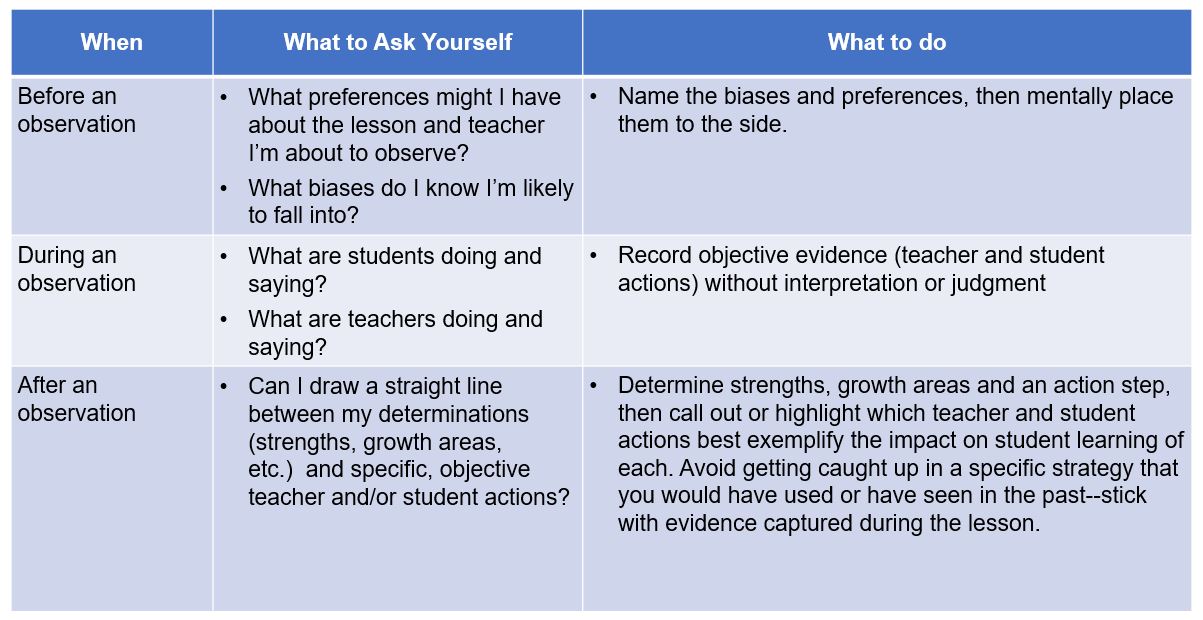Posts Tagged ‘Teacher Development’
Collaborating to Examine Teacher Observation Rubrics for Equity
As an organization that strives to be anti-racist and to advance diversity, equity, inclusion and justice in our work, our Hendy team has taken a close look at our priorities and projects to determine how we can take steps to actively help create anti-racist schools. We believe that every organization should consider where they have influence and take strides to use their influence to proactively address racism, and teacher evaluation rubrics is ours.
As experts in teacher evaluation, and as an organization that frequently supports networks, districts and states to design and implement teacher evaluation rubrics, we identified rubrics as a place that we can advance equity with our clients. We know a lot about rubrics, both about how to write good rubrics, and how to implement rubrics to support teacher development and growth. And, we’ve been intentional about including language about inclusion and diversity in rubrics that we’ve helped to draft and implement. But we hadn’t yet taken an intentional look at rubrics to identify what in the language may be truly advancing equity in teaching and learning, and what might be hindering equity. We also knew that, as a team of four people who all identify as white, we have some critical blindspots in the work of examining tools with an anti-racist lens.
So, before we set out to create a tool, host a workshop, or even publish this blog post, we decided to do the work of examining rubrics ourselves. We contracted with two trusted leaders in Diversity, Equity, and Inclusion (DEI) in education, Carrie Ellis from Celestial Consulting and Ashley Griffin from Bowie State University and BEE Consulting, who themselves are women of color, and asked them to engage in this work with us. We also engaged Talia Shaull from Achievement First and Lisa Friscia from Democracy Prep, both members of Hendy’s Chief Talent Officer cohort, so we could have the perspective of practitioners in the field leading this work in their organizations. As a team we set out to examine the language of four teacher observation rubrics, two that are commonly used in districts and networks across the country, and two that are specific to networks we work closely with. Our intent was to identify specific examples of language, and overall trends in rubrics, that either supported or hindered efforts to advance equity and anti-racism. We also wanted to test a potentially transferable process for examining rubrics with an anti-racism lens.
We started the work by first affirming the role of rubrics in advancing equity and anti-racism in schools, and were honest about what rubrics can and can’t do. Then we examined the content of four rubrics to identify:
- Language or expectations in the rubric that values white dominant norms, values, and culture over those of other racial groups;
- Language in the rubric that is supportive of equity (specific practices, mindset cues for teachers, etc.); and
- Missed opportunities in the rubric to advance equity of instruction for students.
We organized and summarized the themes we saw in each rubric, and discussed those themes together to both align and clarify. In our discussion we surfaced several categories of content that might drive examination of other rubrics for bias and equity.
In addition to categories of content, we also discussed structural features of rubrics, and how those features may or may not advance equity. Specifically, we discussed student-focused vs. teacher-focused rubrics, and the inclusion of DEI as a separate indicator vs. baked in throughout all indicators.
Bringing together experts in different content areas to wrestle with a challenging question was engaging and frankly a lot of fun. We were able to push each other’s ideas, discuss what really matters, debate language and its impact, and learn and grow in the process. At the end of the day, our brains were tired, but we were energized by the ideas we created together and the possibility of sharing with others. We see a significant opportunity to improve rubrics and recognize that while doing so is insufficient for creating anti-racist schools, they do play a critical role in driving teacher practice and leaders’ coaching, and therefore must be improved.
Our work helped us to develop guidance that might support others who wish to examine their own teacher observation rubric, and inspired us to engage others in this work. We look forward to sharing that guidance in a webinar later this spring. If you or your team would like to engage in this work, please reach out. We all have a role to play in advancing anti-racism in our schools, and teacher evaluation rubrics can be a great place to start or continue efforts to ensure equity for all students.
Huge THANK YOU to Carrie, Ashley, Talia, and Lisa from all of the Hendy team!
Hendy Webinar Aug 5: Is your teacher evaluation system ready for Covid-19?
Ensuring that teachers feel safe, valued, and supported is at the heart of successfully reopening schools this fall. Development and evaluation systems can play a big role in defining the teacher’s experience and should be thoughtfully re-designed and communicated to meet those goals. The Hendy Avenue Consulting team has partnered with districts, states and CMOs to identify solutions to the tough questions around how to best develop and evaluate teachers in a remote or hybrid environment in a way that is consistent, fair, and supports teacher growth. We look forward to meeting with you and other system leaders to discuss the challenges, opportunities presented, and possible solutions for effectively supporting and evaluating teachers this year.
Please Join Us: Wednesday, August 5th at 4:00pm EST
REGISTER HERE!
Re-Thinking Teacher Development and Evaluation in 20-21: Facilitated by Hendy Avenue Consulting’s Jeremy Abarno and Sarah Rosskamm, please join other system leaders to learn how to approach teacher evaluation and development in a hybrid or remote environment and to connect with other system leaders in small group conversations and resource sharing.
Don’t You Want to Stay? Virtual Stay Conversations as Key Teacher Retention Strategy
Teacher and staff retention is a common concern we hear from school leaders in “normal” times. One of the most efficient and lowest cost methods we have found for encouraging great teachers to stay is by holding “stay conversations”. A stay conversation is an informal chance to share how much you appreciate a teacher’s work, and to directly ask them to stay at your school for the following school year. Stay conversations don’t take much effort, but they have a big impact. When teachers were asked why they left their school, a common response was simply that no one asked them to stay.*
A stay conversation usually happens in a regularly scheduled one-on-one meeting with the teacher. Stay conversations should begin early in the year, ideally before winter break. Leaders can and should continue to communicate value and priority to teachers throughout the spring. This way, if teachers are presented with an opportunity to leave their school, they know how much they are valued and are less likely to leave.
That’s how stay conversations might proceed in normal times. These, however, are not “normal” times. The challenge and uncertainty of the pandemic makes retaining teachers even more critical. Just because we are all working virtually, leaders should not stop holding stay conversations. In fact, the best practices for stay conversations still apply: keep the conversation brief, affirm how much you value the teacher, and articulate how important they are to your students and school. Be honest about the challenges of remote teaching and uncertainty of what the fall might look like. Then share why the teacher is an important part of the team, especially in this uncertainty. Strong teachers are providing a lifeline to families and students right now, and they will continue to need your great teachers when school restarts in the fall. Finally, ask the teacher directly to stay at your school next year.
Ideally you are touching base with each teacher individually on a regular basis during this time of remote teaching and learning. These one-on-ones can be quick check-ins to ask the teacher how things are going for them, and how you can support them. And they are a great time to say directly how much you value the teacher’s work, and ask them to stay next fall.
P.S. If you need a soundtrack to your stay conversations, try this pop, or R&B, or classic rock, or country, or early 90s style (my personal favorite)!
-Jessica
*From The Irreplaceables, TNTP, 2012.
Celebrating Teacher Appreciation Week 2020
Early May is one of our favorite times of the year. The weather warms, flowers bloom, and teachers are celebrated for an entire week! While we think teachers (and leaders) should be recognized everyday for their tremendous work, Teacher Appreciation Week, this year from May 4 – May 8, is a nice formal opportunity to say thank you.
Though we are teaching, learning, and working virtually, here are 7 ideas for celebrating teachers:
- Send a personal note. More than ever, teachers are inundated with emails and texts. A personal note – sent via the old fashioned, but dependable USPS – can go far for anyone, including your teachers.
- Give a gift. Sometimes, someone taking care of the dinner that night is all you need to make it peacefully to tomorrow. Gift cards, meals from local restaurants, and gift certificates to local businesses are always appreciated. Even a small plant left on the teacher’s doorstep to “decorate their home office” is a meaningful way to say thanks.
- Give time. For leaders, consider cancelling a regular staff meeting and encouraging teachers to use the “found time” to do something for themselves.
- Get families to engage. Ask families to record a short video clip, write notes of appreciation or text pictures of homemade thank you cards.
- Party in a box. Put together a small package of party supplies–balloons, sunglasses, streamers, candy, and a small gift or two–and mail it to each teacher with a label on the outside directing them not to open until a certain date and time. During a staff meeting, have everyone open their boxes simultaneously and start the party!
- Opportunities for input. For some, the greatest recognition is the opportunity to be heard and enhance their impact. Think of ways to bring teachers into decisions–about curriculum, schedules, virtual learning and more.
- Shout-outs. While you may not be physically together, shouting out teachers in meetings, emails, and on social media/websites is a simple, but effective method for letting folks know you value and appreciate them, and a great way to highlight the values you most want your team to exemplify.
Three Lessons for Meaningful Performance Management Incentives
We’re big fans of performance management. We know that for people to achieve their best, they need clear definitions of excellence, resources and tools to achieve that benchmark, and frequent, action-oriented feedback that drives their development. Too often, however, organizations don’t know how to link performance management efforts with valuable incentives for their talent.
Before we dig in, let’s get one thing out of the way: incentives in the workplace are not inherently good or bad. Done well, incentives can be a powerful tool for motivation, recognition and reward. Done poorly, incentives can lead people to feel controlled or set up for failure.
Incentives come in all shapes and sizes but most fit within one of the five Rs:
- Rewards: salary, incentives, bonuses, benefits
- Responsibilities: variety, autonomy, challenge, promotions, learning
- Relationships: coworkers, supervisors, clients, and customers
- Reputations: image, respect, appreciation, feedback
- Rest & Relation: hours, scheduling, flexible, travel, location
So what now? Maybe you want to give a bonus to high-performers, grant newcomers more autonomy or show appreciation to employees who routinely go above and beyond. In any situation, here are three recommendations to help you build a foundation for offering incentives:
- Set achievable, meaningful, and controllable benchmarks for employees. Ambitious goals are great but they should not be impossible to reach. Similarly, desired outcomes must matter to the person and organization. If mission driven, make clear the connection between the individual’s impact and how it helps the the organization get closer to their vision. It may seem obvious, but people also have to know that what they will be measured against can be reached by the levers within their control. We would never evaluate a bank teller by the number of light bulbs that need to be changed monthly, so test your goals to ensure a direct line back to employee actions and responsibilities.
- Know what people want. A huge problem is that organizations generally don’t know what their people want. For example, leaders may assume everyone is motivated by the same things or rely too heavily on what has historically been motivating. Particularly in large or longstanding organizations, there is too much application of the golden rule (treat others as you want to be treated) by decision-makers and not enough of the platinum rule (treat others as they want to be treated). There’s no secret to fixing this problem; you need to do your research (e.g., ask employees, read research on generational shifts, talk to industry leaders) and pilot before full-scale launch. The best approaches customize incentives for specific groups or individuals.
- Keep support and growth at the center. Earning an incentive should not be the end of the journey for your employees. Milestones are important, but should always be coupled with a “what’s next?” conversation so that people feel you are genuinely invested in their growth and development (which we hope you are!) and can tangibly see the road ahead. If one does not yet exist, take the opportunity to co-create. A common pitfall is focusing too much on monetary or extrinsic rewards, sometimes to the detriment of strong intrinsic motivators. Focusing on continual improvement and long-term development will help mitigate this risk.
How have you effectively implemented incentives? What’s been the most interesting outcome? Sound off in the comments below!
Listen Up: Hendy Avenue on EdPOP Podcast
Curious to learn more about Hendy Avenue Consulting? Our very own Jessica Wilson sat down with the host of EdPOP to talk about our mission, recent projects and how talent strategy can make the difference for kids across the country.
Three Steps to Avoid Common Observation Biases
We all have biases. Whether picking an ice cream flavor or choosing to take the scenic route rather than the highway, we all operate with mental models that place disproportionate weight on certain factors that move our judgment in favor of one option when compared to another.
When observing and evaluating teacher practice, there are numerous opportunities for biases to creep in. Just think of all the factors that go into a lesson: the subject, grade, school, teacher, time of day, lesson structure, materials used and more. An observer may think to themselves, “the students were well-behaved for the first class right after lunch”. A different person observing that same lesson may think, “if I was teaching this class, I would have used a different text.” Both of these sentiments may be true, but they have to be placed aside before conducting a visit so that observers can focus on objective teacher and student actions.
In short, great observers, coaches, and evaluators must identify, then set aside, biases in order to fairly and accurately evaluate and develop teacher practice.
Common biases include:
- Confirmation bias: the tendency to search for or interpret information in a way that confirms one’s preconceptions,
- Halo effect: the tendency for a person’s positive or negative traits to “spill over” from one area of their personality to another in others’ perceptions of them, and
- Mirror bias: the tendency to judge performance as “good” if it is “like I would have done it.
A full table of common observer biases with examples can be found here: Observer Bias Examples
In order to mitigate the impact of these biases, great observers should ask themselves three questions:

Round 2: Looking Back, Looking Ahead
In our last post, Looking Back, Looking Ahead: Lessons Learned and What’s to Come in 2018-19, our founder Sarah shared insights on the difficulty of leading change and the excitement around re-engaging with one of our first partners.
This week, we hear from Grant:
What I learned: Historian and philosopher Will Durant said, “we are what we repeatedly do. Excellence, then, is not an act, but a habit.” Durant’s much-quoted line rings true in most endeavors, especially in efforts to drive change. Over the past year, we’ve seen the power of habitual communication–to teachers, school leaders, regional administrators–in sharing consistent messages, building shared understanding and demonstrating competence. Nothing derails stakeholder buy-in more than mixed messages or a lack of information! Habitual communication requires consistent content, format, and tone through a single channel at a regular, expected frequency. In Houston, we’ve supported KIPP in the development of a weekly message to School Leaders around implementation of Teacher Pathways. Each Friday, leaders know they will receive updates, shout outs, resources, and reminders to guide the week ahead. In Delaware, we’ve launched a monthly newsletter for district leaders on DPAS_II, the state’s teacher evaluation system, with a consistent agenda including deadlines and professional development opportunities. These habitual communications do more than provide information, they demonstrate competence and care for colleagues and trust between stakeholders. As you think about the programs you’re leading, consider how you can habitualize communication as a repeatedly do.
What I’m excited about: In 2014, KIPP Texas – Austin began a comprehensive effort to reshape teacher effectiveness and retention through the development of a Teacher Career Pathway. Knowing that great teachers drive student achievement, Austin’s Teacher Career Pathway develops, recognizes and rewards excellent educators so they will get better and stay longer. This fall, the first cohort of Distinguished Teachers will be announced; a group of accomplished educators who have demonstrated consistent gap-closing results for kids, impeccable teaching practice and exemplary professional contributions to the school community. We cannot wait to celebrate these remarkable educators!
Looking Back, Looking Ahead: Lessons learned and what’s to come in 2018-2019
As consultants, our role is to guide our partners to make informed decisions and to successfully meet their goals. We also prioritize building the knowledge and skills of our partners and they tell us that they learn a lot from working alongside us. In turn, we learn so much every day from the incredibly smart and diverse partners we have the good fortune to work with!
As we reflect on the past and look ahead to the new school year, we are grateful for all that we have learned from our clients. In our next couple of blog posts, each Hendy team member will share something he or she has learned and something we’re excited about it. It’s going to be a great year!
To kick us off, read below from our founder, Sarah Rosskamm:
What I learned: Change is hard. Often times the solution is to prepare for change, engage stakeholders, continuously communicate the “why”, work with influencers, plan for challenges and ultimately to just keep going even when it gets tough. There are times, however, when the solution is to pause, reflect and change course. In working with one of our partner charter networks this year, we learned that sometimes the most courageous and best answer is to stop doing something. In this case, our partner was eager to build a teacher career pathway. They took many important steps to get there, had buy-in from leaders and momentum from teachers believing it was valuable. However, they also had budget changes, shifts in capacity and new demands of their attention. As a result, they smartly decided to pause. They stopped putting their attention into the pathway and instead narrowed the scope of their focus to implementing a highly effective evaluation and development structure that would help their teachers to grow and enable them to target their professional learning activities. They focused on laying a foundation that would immediately benefit teachers through continued growth, and will ultimately allow them to move more quickly toward a pathway if and when they choose to pick it up again. It wasn’t easy (for the network or for the Hendy team) to not complete our original shared goal, but it was the right thing to do for their teachers and students.
What I’m excited about: Hendy Avenue’s very first consulting project was supporting the Delaware Department of Education as they considered revisions to their teacher evaluation rubric. After considering several rubric options based on the best of the available rubrics at the time, the Delaware team, similar to the team described above, decided to pause and learn more before making changes to a statewide tool. So, we shifted course and supported four charter schools in Wilmington to design and implement an alternative evaluation system for their teachers that would utilize this new rubric. I worked closely with the leaders in those schools for several years and together we instituted an alternative system that is now used in a growing number of Delaware schools through their Alternative Evaluation system. I am so excited that five years later, after learning a great deal about the use of the current rubric and about the alternative system, Delaware leadership is eagerly partnering with teachers, leaders and other stakeholders to revise the rubric to ensure the tool is well-aligned to new standards and meets the needs of teachers across the state. I’m also thrilled the state has very wisely decided to prioritize involvement of teachers and leaders in the process and to take the time necessary to ensure it’s a positive and welcomed change for their well deserving teachers. And I’m even more excited that Hendy Avenue will be partners in engaging stakeholders, designing, piloting, revising and ultimately building a rubric that helps teachers and leaders be the very best they can be for their students.
Make Your Pick: How the NFL Draft Applies to Teacher Hiring
While there is a lot of best practice research out there about how to hire a great team, leaders seeking teacher talent can take a cue from how professional sports teams scope out and draft players. In the post below, we bring Cade Massey’s article on 5 lessons we can learn from the NFL draft into the world of teacher hiring.
1. Know what you need. Before you even begin to recruit teachers, be clear on what type of teacher you need for your school. Of course, certification, grade and subject-area matches matter, but identifying a great fit requires more. Assess your current staff to identify where your team has strengths, and where there are gaps. Perhaps you need a teacher with great data skills who can support your team’s efforts to review and act on student outcomes. Or perhaps you need a teacher who can effectively implement writing across the curriculum. Also consider your strengths as a leader; do you have capacity to coach a novice teacher? Or do you need someone with more experience? Being clear about the ideal profile of a candidate can help ensure that you focus your limited resources on a hiring process that will yield the best outcome.
2. Get input from others. While the school leader is often the driver and decision-maker when it comes to hiring, ensuring that teachers, other leaders, and even parents are engaged in selection will help ensure that the best candidate is chosen for the school. Consider a process that allows you to solicit input and ideas from a variety of stakeholders. Allow each stakeholder to have an independent review of finalists, and to form their own perspective about fit. One easy way to engage multiple stakeholders quickly is to use a panel interview, or to have multiple stakeholders act as students in a demo lesson (see item 3).
3. Understand the candidate from multiple angles. Resume reviews and interviews are a great first step in getting to know a teacher candidate. But, often that isn’t enough. As football scouts actually see candidates play, getting a glimpse of your top candidates teaching will help you understand how they may fit into your school culture. Request a video of the candidate teaching, or request that they teach a demo lesson in your school or with your selection committee. Even observing 10 minutes of teaching can help you get a full picture of the candidate’s skills and growth areas.
4. Be consistent in your selection model. Hiring is about assessing people, which can be a messy business. No matter how disciplined we are, our opinions of others are naturally informed by the biases we carry; we’re all human after all. As you design your selection approach, consider a rubric and scoring mechanism that makes considering multiple variables factors more formulaic. Bringing order and data to a process like hiring can help ensure that factors like selection bias do not play a significant role in who is selected for your school.
5. Keep score and reevaluate. The only way to know if your selection process worked is to map it against results. Once you’ve selected your dream candidate(s), keep a record of the selection process and the factors that led to their hire. Then, after their first year, compare the teacher’s results to your selection. How accurate was your assessment of their strengths and growth areas? Did your selection approach yield a candidate that made gains with students? If so, what should you replicate? If not, what might you tweak for future hiring?
Sound off in the comments: What lessons have you learned from teacher hiring? What strategies have been most useful in identifying your best candidates?








